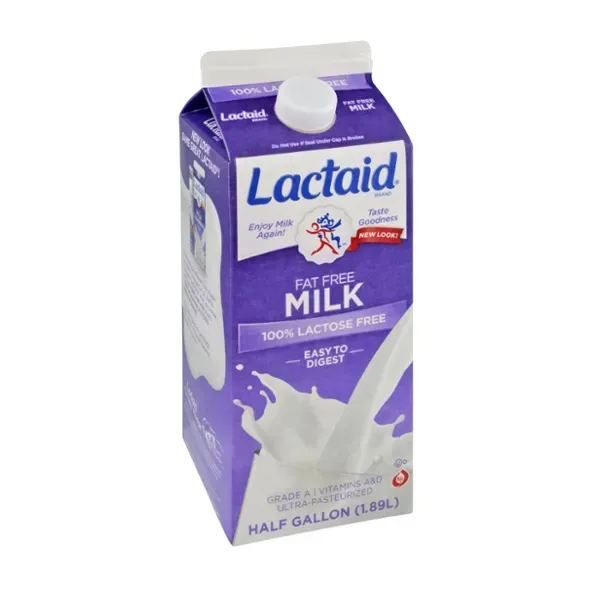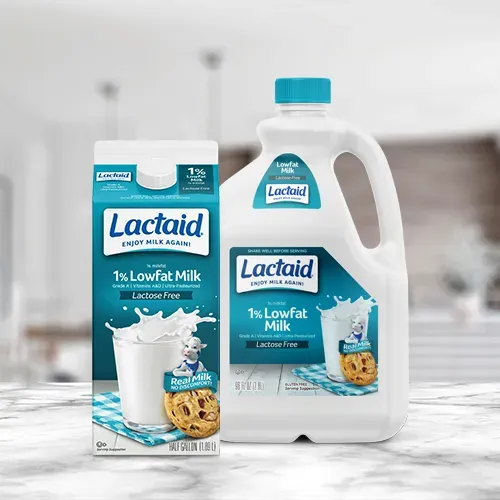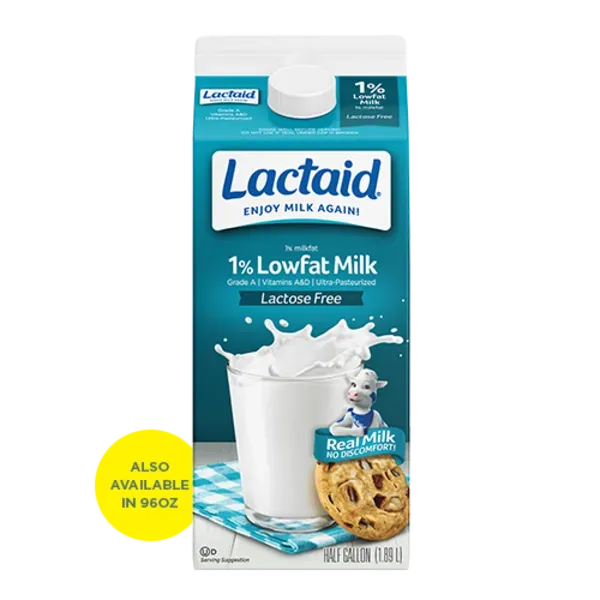Table of Contents
Let's be honest, sometimes milk just doesn't agree with you. That creamy goodness turns into a gut-wrenching symphony of discomfort. If you've ever felt left out of the cereal club or skipped adding milk to your coffee because of lactose intolerance, you're not alone. Millions deal with this daily. But what if you could have your milk and drink it too, without the drama? Enter **lactaid low fat milk**. It promises the taste and nutrition of regular milk, just without the lactose that causes trouble for so many.
What Exactly is Lactaid Low Fat Milk?

What Exactly is Lactaid Low Fat Milk?
Breaking Down the Lactose Bit
so you grab a carton of **lactaid low fat milk** and wonder, "Is this just regular milk trying to be fancy?" Not quite. The main difference boils down to one sugar: lactose. Regular cow's milk naturally contains lactose. For folks who are lactose intolerant, their bodies don't produce enough of the enzyme called lactase, which is needed to break down that lactose. Undigested lactose hits the large intestine, and that's when the party starts – or rather, the bloating, gas, and general unpleasantness.
What Lactaid does is add that missing lactase enzyme right into the milk during processing. This enzyme gets to work, breaking down the lactose into simpler sugars (glucose and galactose) before you even drink it. Think of it like pre-digesting the lactose for you. So, by the time it hits your gut, the troublesome sugar is already broken down, preventing those uncomfortable symptoms.
Still Milk, Just Without the Drama
Beyond the lactose situation, **lactaid low fat milk** is still, well, milk. It comes from cows, and it contains the same essential nutrients you'd find in regular low-fat milk. We're talking calcium, vitamin D, protein, and riboflavin. The "low fat" part means it has roughly 1% milk fat, just like standard 1% milk. It's not some chemical concoction or a plant juice trying to pass as dairy.
Because the lactose is broken down into simpler sugars, some people notice a slightly sweeter taste compared to regular milk. It's not like adding sugar, though; it's just how those simpler sugars register on your tongue. The texture and color are pretty much identical to regular low-fat milk. So, you get the nutritional benefits and creamy mouthfeel without the digestive rebellion.
Here's a quick rundown of what makes it different:
- Contains added lactase enzyme.
- Lactose is pre-broken down into simpler sugars.
- Still contains essential milk nutrients (calcium, vitamin D, protein).
- Has approximately 1% milk fat.
- Tastes slightly sweeter than regular milk.
Who Benefits Most from Lactaid Low Fat Milk?

Who Benefits Most from Lactaid Low Fat Milk?
Living symptom-free with lactose intolerance
so who actually needs to bother with **lactaid low fat milk**? The most obvious group are those diagnosed with lactose intolerance. You know the drill: that uncomfortable feeling, the bloating, the gas, sometimes worse, that hits after you've had a glass of regular milk or a scoop of ice cream. It's your body telling you it's struggling to break down the lactose. Switching to Lactaid milk means you're giving your digestive system a break. The lactose is already handled by the added enzyme, so those classic symptoms usually vanish. It's not a cure for intolerance, mind you, but it's a workaround that lets you enjoy milk again without planning your day around potential bathroom trips.
Getting milk's nutrients without the digestive drama
Beyond just avoiding discomfort, **lactaid low fat milk** is also a solid choice for anyone who wants the nutritional punch of dairy but finds regular milk causes mild indigestion or just feels "heavy." Maybe you're not full-blown intolerant, but you notice *something* isn't quite right after milk. Lactaid can offer a smoother ride. It's still packed with bone-building calcium and Vitamin D, plus protein, without the lactose load. It's also a good option for kids who might be sensitive or for older adults whose natural lactase production might be declining. Think of it as standard low-fat milk, just... easier on the gut.
Here's a quick look at who might find Lactaid milk useful:
- Individuals with diagnosed lactose intolerance.
- Anyone experiencing digestive discomfort after consuming regular milk.
- People seeking milk's nutrients (calcium, Vitamin D) without the lactose.
- Parents managing mild dairy sensitivities in children.
- Older adults with reduced natural lactase production.
Comparing Lactaid Low Fat Milk to Regular and Other Alternatives

Comparing Lactaid Low Fat Milk to Regular and Other Alternatives
Lactaid Low Fat vs. The Original
so you're standing in the dairy aisle, staring down the regular milk and the carton of **lactaid low fat milk**. What's the real difference, beyond the whole lactose thing? Nutritionally, they're practically twins when it comes to the good stuff like calcium, vitamin D, and protein. You're not losing out on those bone-building nutrients just because the lactose is gone. The fat content is the same too, sitting around 1% for both low-fat versions. The big, glaring difference is how your gut handles it. Regular milk throws a lactose curveball that some bodies just can't hit. Lactaid milk removes that problem by breaking down the lactose beforehand. Think of regular milk as needing a specific key (lactase) to unlock its sugar, while Lactaid milk comes pre-unlocked. For someone who gets bloated and gassy from regular milk, making the switch to Lactaid low fat milk is like trading a bumpy dirt road for a smooth highway.
How Lactaid Low Fat Stacks Up Against Plant Milks
Now, let's talk about the other players in the milk alternative game: almond, soy, oat, rice, you name it. These are fundamentally different because they don't come from cows at all. They're made from plants and water, often with added vitamins and thickeners. While many are fortified to match milk's calcium and vitamin D levels, their protein content varies wildly. Soy milk is usually closer to dairy protein levels, but almond and rice milk often have very little protein. Oat milk sits somewhere in the middle. Lactaid low fat milk, being cow's milk, offers a complete protein source naturally. Plant milks are great if you're vegan, allergic to dairy protein, or just prefer the taste. But if your only issue is lactose, and you still want the nutritional profile and taste of dairy, Lactaid low fat milk is the direct dairy substitute that keeps you in the milk family without the lactose fallout.
Here’s a quick comparison point:
- **Lactaid Low Fat Milk:** Cow's milk, lactose removed, good protein, calcium, Vitamin D. Tastes like milk.
- **Regular Low Fat Milk:** Cow's milk, contains lactose, good protein, calcium, Vitamin D. Can cause digestive issues for some.
- **Plant Milks:** Not dairy, varying protein/nutrient levels, often fortified. Different tastes and textures.
Considering Other Lactose-Free Strategies
Of course, **comparing lactaid low fat milk to regular and other alternatives** isn't just about swapping cartons. There are other ways to manage lactose intolerance. You could take lactase enzyme pills or drops *before* consuming regular dairy. This works for some people, essentially doing the same job as the enzyme added to Lactaid milk, but you have to remember to take them every time. The convenience of Lactaid milk is that the work is already done. You just pour and drink. Also, hard cheeses and yogurt often have less lactose than milk because of the way they're processed, so some intolerant individuals can handle them in moderation. But for that glass of cold milk or using milk in recipes, Lactaid low fat milk often provides the most straightforward solution without needing extra steps or risking symptoms.
Real Talk: The Taste and Texture of Lactaid Low Fat Milk

Real Talk: The Taste and Texture of Lactaid Low Fat Milk
Does Lactose-Free Mean Flavor-Free?
let's get down to the nitty-gritty: what does **lactaid low fat milk** actually *taste* like? If you're expecting something wildly different from regular milk, you might be surprised. The most common feedback is that it tastes slightly sweeter. Remember how the lactase enzyme breaks down lactose into glucose and galactose? Those are simpler sugars, and they register as sweeter on your tongue than lactose does. It's not like adding a spoonful of sugar, though. It's a subtle difference, more of an underlying sweetness. Some people don't even notice it, especially when pouring it over cereal or mixing it into a smoothie. Others find that slight sweetness makes it even more palatable for drinking straight. It definitely doesn't taste "processed" or artificial. Think of it as regular low-fat milk that went to finishing school and learned to be a little more polite to your taste buds.
Same Creamy Feel, Different Gut Outcome
Beyond the taste, the texture of **lactaid low fat milk** is practically indistinguishable from standard low-fat milk. It has that familiar smooth, slightly creamy mouthfeel you expect. You won't find it thinner or thicker just because the lactose is broken down. This is key for using it in recipes. Baking, cooking, making sauces – if a recipe calls for low-fat milk, you can swap in Lactaid low fat milk without messing up the consistency. This isn't always the case with plant-based alternatives, which can have different viscosities and sometimes curdle unexpectedly in heat. With Lactaid, you get the reliable performance of cow's milk in the kitchen, just without the potential for post-meal distress. It pours the same, mixes the same, and feels the same on your tongue.
Here's the lowdown on taste and texture:
- Slightly sweeter taste due to broken-down lactose.
- Sweetness is subtle, not sugary.
- Texture is the same as regular low-fat milk.
- Works well in recipes without changing consistency.
- No artificial or 'off' flavors often associated with some alternatives.
Tips for Incorporating Lactaid Low Fat Milk into Your Diet

Tips for Incorporating Lactaid Low Fat Milk into Your Diet
Making the Switch Seamless
So, you're ready to give **lactaid low fat milk** a shot and ditch the dairy distress. Good call. Swapping it into your daily routine is usually pretty straightforward because, as we covered, it acts and tastes so much like regular milk. The easiest way to start is just a direct swap: use it in your coffee, pour it over your cereal, or drink a cold glass just like you would standard low-fat milk. No complex calculations or recipe adjustments needed. Because the texture is the same, it works beautifully in things like smoothies, pancakes, or even creamy sauces where regular milk was causing issues. Don't overthink it; just swap it in cup-for-cup wherever milk is called for. It's designed to be an easy replacement, not a culinary puzzle.
The Verdict on Lactaid Low Fat Milk
So, what's the final word on lactaid low fat milk? For many dealing with lactose intolerance, it serves as a practical alternative to traditional dairy, offering similar nutritional benefits without the digestive fallout. It doesn't perform miracles, but it does remove the primary culprit for discomfort. While taste is subjective and alternatives exist, lactaid low fat milk holds its ground as a widely available, familiar option for those unwilling to give up cow's milk entirely. It's not a one-size-fits-all solution, but if you're navigating lactose issues, it's certainly worth considering as a regular part of your diet.
